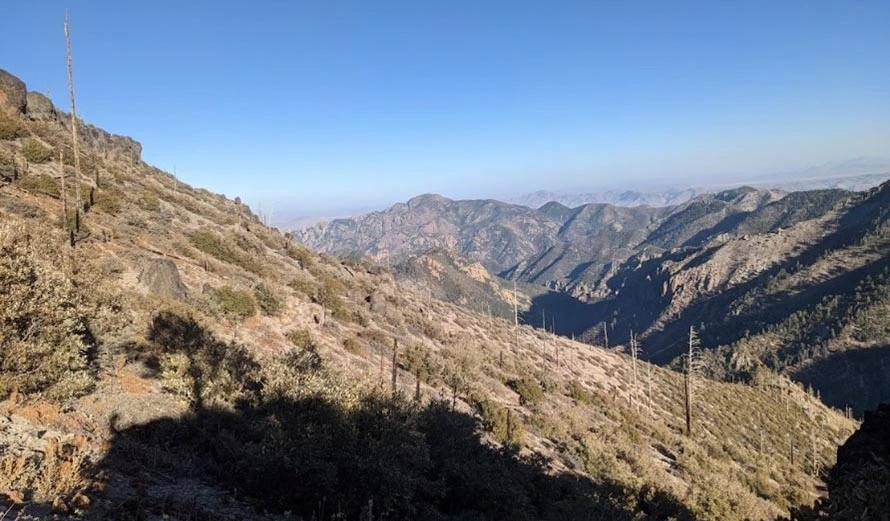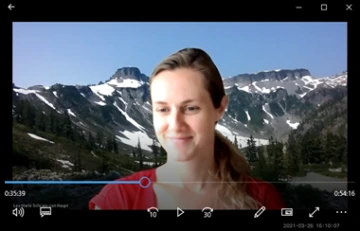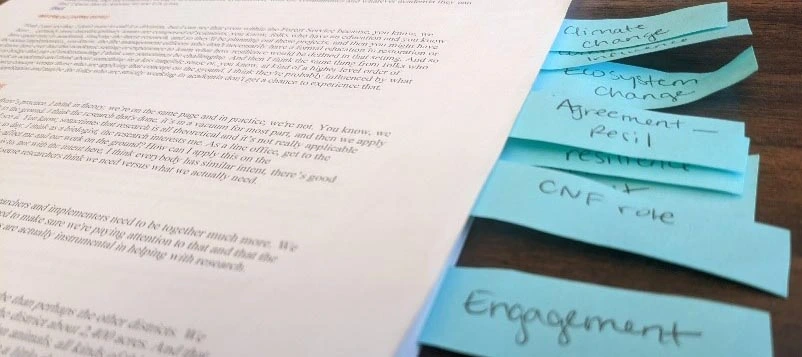Lessons Learned as a CLIMAS Environment & Society Fellow
In my year as an Environment & Society Fellow with CLIMAS, I learned just as much about the research process and collaborative research as I did about my actual research topic. I learned that things almost never go as planned or according to schedule, and whatever your original vision for your research was will probably change and evolve into something different – and probably better.

Figure 1. Image of the Chiricahua Mountains in southeast Arizona, recovering after a wildfire. The Chiricahua Mountains are one of the sky islands managed by the Coronado National Forest.
I partnered with the Coronado National Forest to get a better idea of the challenges that face staff when planning and executing landscape-scale fire restoration plans. We spent somewhere between 6 and 9 months in discussions with Coronado National Forest staff and University of Arizona faculty, working to find the nexus between what various staff on the Coronado needed, my own research interests, the perspectives and expertise of my advisors, and what was feasible given the timeline of a master’s thesis.
Collaborative research takes time – a lot of time – and involves striking a balance between all of the various participants. There is a lot of give and take, a few steps forwards and a few steps back. And that balancing act doesn’t end with the research question. As I dove into designing the research plan, who I was going to interview, how the survey was going to be structured, and what questions I would ask, our goals morphed and changed from a focus on the National Environmental Policy Act and stakeholder engagement strategies to fire restoration challenges in both planning and implementation and staff and stakeholder views on the Coronado National Forest’s role in managing these ecosystems during a time of climate change and unknowns.

Figure 2. A screenshot from one of the 17 zoom interviews conducted virtually with Coronado National Forest staff.
I conducted 17 semi-structured interviews with Coronado National Forest Staff and collected survey responses from 182 stakeholders over the course of a few months in Spring 2021. Due to the pandemic, interviews were conducted virtually. Because we had all spent the better part of the last year on Zoom and Microsoft Teams, we were all pretty comfortable with connecting virtually, although it would have been nice to also see, in person, some of the areas and strategies that my interviewees were discussing.

Figure 3. After transcribing the interviews, the transcriptions were coded by broad themes in RQDA (Qualitative Data Analysis in R) for further analysis.
After doing qualitative data analysis on the interview transcriptions and the open-ended responses to the survey, as well as preliminary quantitative analysis on the survey questions, I began to wrestle with the deeper data analysis process. As a student, doing a master’s thesis tends to feel like you’re learning as you go. Every step of the way you learn new things and realize how you could have done things differently if you were to do it over again. And particularly with my research, I felt overwhelmed by the task of narrowing down everything that I was discovering in my data to a few useful and meaningful takeaways for the Coronado National Forest staff and their stakeholders.
It meant a lot to have the support and understanding of the CLIMAS mentors as I struggled through this. The benefits of collaborative research are clear and often talked about, but the challenges and struggles aren’t always quite as transparent. It was invaluable to be able to discuss data analysis strategies with people who had done similar research to me, particularly in a collaborative research setting. It made a huge difference to have my experiences and struggles acknowledged and validated by other researchers, even people who have been doing this kind of work a lot longer than I have.
A few key takeaways stood out to me in my research. Interestingly, there were very few ways in which stakeholder and staff views diverged in relation to fire restoration practices, perspectives on ecosystem change, and CNF’s role in managing the resources. The public is highly supportive of prescribed burning and mechanical treatments and believes that the long-term benefits of fire restoration are worth the short-term impacts. Herbicide use and prescribed grazing remain, unsurprisingly, the two controversial practices. If CNF is interested in using any of these strategies in future plans, it would be worth dedicating time and resources to lay the groundwork with appropriate public outreach, education, and collaboration.
Given how surprisingly aligned the majority of stakeholders and staff seem to be based on the data in the surveys and interviews, there seems to be a breakdown when it comes to communicating across those boundaries. Stakeholders don’t feel particularly heard nor do they feel CNF adequately explains what they’re doing and why, outside of active incidents like the Bighorn Fire. It takes a lot of staff time to communicate, educate, collaborate, and dialogue well. Almost all study participants recognized the lack of time, money, and resources the CNF has, but it may be worth identifying ways to improve that won’t require significantly more time or money.
I really enjoyed the learning process and working with both my partner organization and CLIMAS. As I move towards wrapping up a report for the Coronado National Forest, I’m thankful to have had the support and understanding of such a great team behind me.

